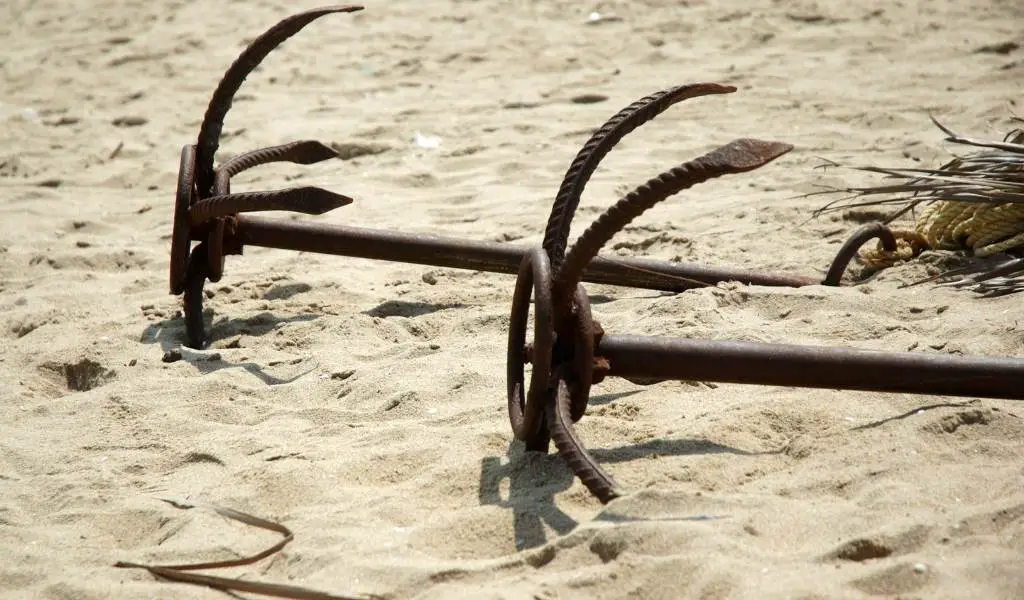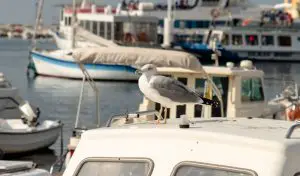There once was a time when it was much more common to see boats using multiple anchors. Modern “new generation” anchors have nearly eliminated the need for two anchors. While modern anchors offer advanced designs that maximize holding power, they are also designed to set themselves quickly into many types of bottom substrate.
The most significant benefit of having an anchor that sets quickly and efficiently is that it should reset itself if it ever should pop out. Anchors can “pop out” for a variety of reasons, but the main one is that the boat pulled on it from a different angle than it initially was set. If the wind or current shifts, the chain might start pulling on the anchor from 180 degrees opposite to how it was placed. In this case, the anchor might pop out of the bottom and drag.
Are Two Anchors Better Than One?
One way to prevent this is to use two anchors. With two anchors, the idea is that there is never a direction that the boat could pull that it would pull an anchor out of the bottom. In the example of a 180-degree wind or current swing, there would be another anchor aligned and set, ready to take that load. The original anchor would stay in place and be prepared to hold the boat when the wind or current shifted again.
If you have your second anchor stowed away for emergency use only, you’ll have to start thinking about setting it up properly to use as a second anchor. It should have at least some chain and be of the appropriate size to hold the boat. Often boaters will use a different design of anchor for their secondary, be it so that it stows away easier or gives them more choices when anchoring on different bottom types.
When Should You Use Two Anchors?
There are two primary reasons you should launch two anchors. In both instances, you’re looking to stay awhile. It is quite a bit of work to launch two anchors. Even on many cruising boats that have large windlasses, that windlass is usually only set up for the primary anchor. This is fine since a vast majority of your anchoring is done with your primary alone.
Swing Room
The first situation you need to consider two anchors is when swing room is extremely limited in small anchorages. Take a look at the other boats in the area. Are they sitting on one anchor or two? It can sometimes be hard to tell at a distance, especially since most skippers rig snubbers and bridles as well as their primary line. When in doubt, ask.
If other boats are using one anchor, their swing radii are going to be wildly different than a boat riding on a single anchor. On one anchor, a boat will swing in a 360-degree circle as the wind or current shifts around. The radius of the circle is approximately equal to the amount of rode the boat has paid out. If the boat has 100 feet of chain out, their swing circle will be 200 feet across.
Even in tight anchorages, this can work if everyone has about the same scope out and is also using only one anchor. The boats will generally swing in the same circles. It can be tough to judge, and not knowing how much rode other captains have used puts every other boater at a disadvantage.
Imagine, though, if one boat in the middle is lying on a permanent mooring. While other boats move in large arcs around their 200-odd foot circles, the boat on the mooring remains more or less stationary. It is very likely that one of the 200-foot circles intersects with the location of the boat on the mooring. Things can bump in the night if the skippers aren’t careful.
The same scenario can play out if one boat is using two anchors. Two anchors change the swing circle of a vessel. If all other boats in the area are using one anchor and making 200-foot swing circles, the boat on two anchors will remain nearly stationary.
For this reason, you must match the technique used in an anchorage when you arrive. Either you confirm that everyone is using one or two anchors and do so yourself, or you anchor sufficiently far away from them that it isn’t a problem either way.
Increased Holding Power
The second reason you might choose to use two anchors is to decrease the chances that your single anchor will drag. Dragging anchor is no fun, and if the wind is coming from offshore or the anchorage is tight, it can be dangerous.
Even if you did all of the best research and bought the best anchor you could afford, dragging is still a genuine possibility. No anchor can hold in all conditions. Generally, boaters try not to anchor where the holding is poor, but sometimes they have no choice. And sometimes they are unaware of just how bad the holding is.
It is relatively easy to drop the hook and make sure it sets—the problem arises after the initial set when conditions change. If the wind or current shifts suddenly from a different direction, the boat will no longer be pulling on the anchor in the same way that it was when it was set.
Everyone gets caught off guard once in a while. But these sudden changes have some warning. Current shifts can be expected anywhere tidal currents are present– what goes out must also come in. Wind shifts are a different matter. Cold fronts bring squall lines and sudden wind shifts that challenge your anchoring skills. But they also provide at least a day or two of notice before they come, as long as the skipper is monitoring the weather. The anticipated wind directions are often very accurately forecasted.
Tidal current reversals and cold front passages are perfect examples of times when two anchors might be better than one. You can, in advance, set an anchor to hold the boat into the outgoing tide and the incoming tide. In the case of a cold front, you can place an anchor to hold the boat into the present wind conditions, and another into the anticipated frontal winds. Knowing that each anchor is set correctly in advance will give the captain a lot of comfort with the knowledge that nothing is left to chance.
Watch this video to learn more about anchoring your boat with two anchors.
How to Use Two Anchors
There are two primary ways to use two anchors off of a boat. You could put both anchors off of the bow, ensuring that the boat will still swing into the current or wind. This is known as a Bahamian mooring. Another option, used in rivers or when beaching, is to rig one anchor off the bow and one off the stern.
Here is a breakdown of each method and everything you need to know:
Method 1: Bahamian Mooring
The Bahamian mooring is a versatile tool that every captain should be able to rig. It gets its name from its usefulness in the Bahamian islands, where narrow channels are subject to lots of tidal currents. With a properly set Bahamian mooring, a large boat can sit right in the middle of a tight channel or creek, swinging on the current with each tidal shift.
To set a Bahamian mooring, start by setting your primary anchor like you usually do. Make sure it is set well, and payout twice as much scope as you need to. Drop the second anchor in approximately the direction the next tidal current will flow or the direction you expect the wind to shift to. You might have to use the engine to maneuver the boat where you want it.
Once the second anchor hits bottom, start retrieving the line from your primary and letting out your secondary. You want to position yourself half-way between the two anchors.
Somehow, you’ll need to set the second anchor you dropped. You can tie it to stern cleat and power forward. Be careful not to get the line anywhere near your propeller, since you don’t want to foul the prop or cut the line.
Once both anchors are well set, and you are positioned half-way between them, tie both anchors off at the bow. The boat will now swing into the wind or current, and on each wind or current shift, there should be an anchor directly ahead, taking the load. The other anchor line should be slack when not in use.
The amount of swing will depend on a number of factors, including the heights of the tides and the amount of slack in the lines. The boat will swing in a small arc as it hangs off of one anchor, but if it starts shifting too far to one side or the other, the slack anchor will come taught and keep the boat in place. As a result, the vessel doesn’t move very far and always remains between the two anchors.
Method 2: Bow and Stern Anchors
Setting your second anchor off of the stern is less desirable for a few reasons. A boat in this design is not going to swing into wind or current as they change, which means that the vessel is going to put a significant sideload onto those two anchor lines.
With planning, putting two anchors out in this fashion can be helpful in extremely narrow rivers and creeks where the current flow is predictable. Since the boat cannot swing and you want to minimize those side loads, you’ll need to place the boat aligned with the current. Position the bow into the greatest force expected, be it into the ebb tides or most aligned to the forecasted winds.
Boats riding off bow and stern anchors will not swing at all. They may move side to side, notably as the tide lowers, and they get more slack in their lines. In some parts of the world, moorings are set up in this fashion. These are known as trot moorings.
The same technique can be used to hold a boat in a position along a shoreline. Mediterranean moorings are boats anchor at the bow and tied to a dock or quay at the stern. Many boaters anchor their vessels on beaches in this manner.
Alternative Methods for Dual Anchors
Although Bahamian Mooring and the Bow and Stern method are the most common ways to use two anchors. There are a couple of other methods that I’ll share with you, although these have more specific use cases:
Two Anchors in Tandem
If you have incredibly high winds coming and you wish you’d bought a bigger anchor, there’s another trick you can use. It is possible to rig two anchors on one anchor line. This is known as tandem anchoring.
Navy tests have demonstrated that two anchors working in tandem like this can have more holding power than is possible to have with both of the anchors rigged separately. The primary benefit comes from the secondary anchor or the one closest to the boat. This anchor will keep the rode down low, giving the primary its maximum holding power. Any wind shifts or pulls will have to dislodge the secondary anchor first before they can even think about budging the primary.
The devil is in the details, of course. Getting these two anchors to set correctly is tricky, as is retrieving them. It’s not an exercise most boaters will want to make for every anchoring stop, but it can be a helpful technique if very nasty weather is headed your way. The second anchor in the line will need a special attachment point to set correctly.
Permanent Moorings with Swivels
Another way to rig multiple anchors is to make your own mooring. This isn’t very common, but if you’ve got a patch of water where you’d like to hang out awhile, putting three or more anchors on the bottom can leave your boat safely moored for long term storage.
On the bottom, the three anchors will connect to a heavy-duty anchor swivel. From the swivel, the chain will go to the boat. The idea is that as the boat swings in its circle, it will always be pulling on one or two anchors on the bottom.
Making this set up is not an easy or inexpensive undertaking. To ensure that they are set and will not tangle one another, you’ll probably need to dive on them.
When Should You Avoid Using Two Anchors?
One thing that you never want to do is rig two anchor lines inline off of the bow. If you’re worried that your primary anchor might drag, the last thing you want to do is add another dragging anchor and line to the mix. More likely than not, the primary will drag into the second anchor and foul its line. Then you’ll have a real mess.
Using two anchors can solve a lot of problems, and if you think two might help you, you should not hesitate to try. But generally speaking, don’t use two when one will do. Make sure your primary anchor is oversized and up for any task. Modern anchors have reduced the number of times boaters need to resort to using two anchors. Nonetheless, it’s still a handy trick to have up your sleeve, especially if you enjoy gunk-holing or long-distance cruising.




